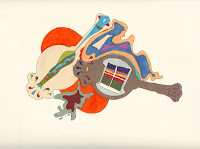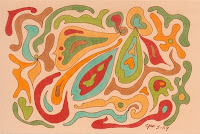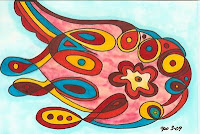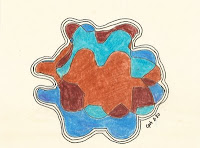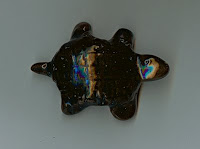As can be seen from my drawings, I'm not a trained artist. I just love to draw and color. Most of the time, I do a line drawing, then color it with my markers. Sometimes I start with a pencil sketch or rough layout, but not always. Sometimes I draw and color alternately.
When I'm not drawing "from life," my drawings often begin with what I call a gesture. An arm movement. A line on a page. That leads to another gesture, another line. At some point, I start to add lines that fit with the lines I already have. Sometimes it begins to look like "something," and I make it look more like that. (Example: Mary 1 of 12) Often I don't know what I'm drawing until I'm well into it, and sometimes when I'm done, I still don't know what it's supposed to be. (Example: Flower or...?) That doesn't bother me.
Do I always end up with a great drawing, even by my standards? No. And it can be an uncomfortable process. A few months ago, I wrote to my friend Sybil:
"For about half of my drawings, there is a point where I think that it's ugly, unfinishable, unsalvageable. I have the strong urge to rip it up. But I've learned to take a breath, turn the paper around, let myself 'commune' with what is there, and wait for it to tell me what it needs. Another line, another color, some shading or whatever. And if I don't rush it, don't get anxious, don't just do 'something, anything' to make it stop - then it turns out beautiful in its own way. And that's my secret for artistic success. I let it be what it is. For some reason, that works for me with lines & markers, but not with crayons or paint or colored pencil."Another note to Sybil, on a similar topic:
"After I finish a picture that that is near the top of my current 'artistic' capabilities, like the iris, I'm much more critical of the next one, like the gaudy fish. After the subtle, complex shading in the iris, I wanted to make something simple and bright (really bright!), and I did. But when it (the fish) was done, part of me was disappointed, and I had to remind myself that I enjoyed making it, that not every drawing needs to be a pinnacle."

